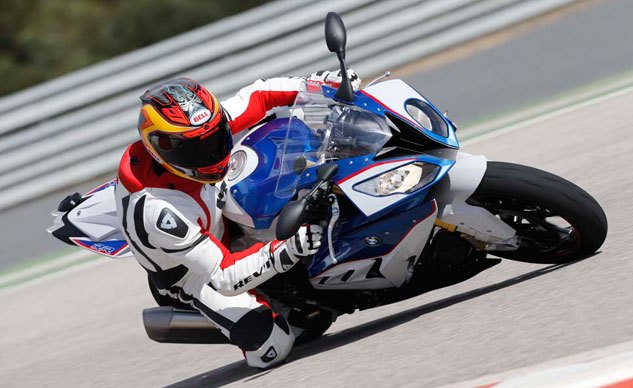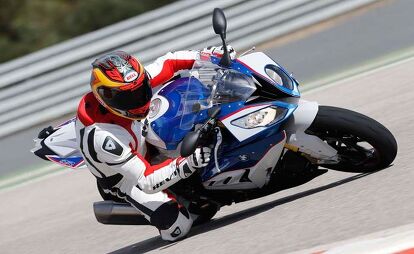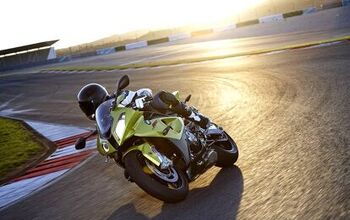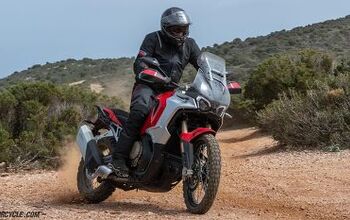2015 BMW S1000RR First Ride Review + Video
With the Race and Dynamic packages installed, it's an HP4 in all but name, maybe a little better
Hyped up on residual adrenalin from the previous day’s track outing at the Circuito Monteblanco, and feeling a little light-headed after visiting the open bar in the captain’s lounge at Adolfo Suárez Madrid–Barajas Airport (one hour flight delay), I began typing my 2015 BMW S1000RR review. Oh, S1k double-R, how I love you, let me count the ways: Gear Shift Assist Pro, Dynamic Traction Control (DTC), Dynamic Damping Control (DDC), Cruise Control …
Wait a second – thought a more sober me somewhere mid-Atlantic – those aren’t stock items on the RR. You only get those goodies after spending the money to upgrade the base model RR with the Race Package (Pro riding mode, DTC, cruise control) and Dynamic Package (DDC, HP Gear Shift Assist Pro, heated grips, LED turn indicators). Tricky, BMW. Of course the attending media is gonna be enamored with a day aboard an RR outfitted to the tune of an HP4.
So, an evaluation of a base model S1000RR is gonna have to wait until we get a 2015 version in our possession, but if you’re thinking you might order an RR outfitted with the latest and greatest performance upgrades BMW has to offer, you’ll definitely want to hear what we have to say. The only thing we don’t know right now is how much it’ll cost you because BMW has not released 2015 pricing for the base model bike or its upgrade packages. Check back in about three weeks, says BMW.
Regardless your personal preferences of style, engine architecture, ergonomics, etcetera, BMW’s S1000RR is, inarguably, one helluva a damn good sportbike. I admittedly have an on-going love affair with Aprilia’s RSV4 – its handling and the oh-so sexy sound of its V-Four exhaust note – but if it ever came down to me spending my own moola on the best all-around sportbike, I’d be hard pressed to buy the Aprilia over the BMW. The Beemer’s streetability is simply unbeatable in sportbikes terms.
We’ve exhaustively reported on the principle changes to the 2015 S1000RR ( 2015 BMW S1000RR Preview + Video, Intermot 2014: 2015 BMW S1000RR) so I’ll dispatch with the formalities and get right into the riding impressions of this new double R.
According to BMW engineers and test riders the key phrase associated with the RR’s development is rider-friendliness. How to make a bike with 199 claimed horsepower manageable to the average road rider while keeping things exciting for hardcore track enthusiasts. In essence, BMW improved the S1000RR by way of broadening its appeal rather than by sharpening the scalpel.
2013 Exotic Superbike Shootout: Street – Video
For a liter bike, the tight Circuito Monteblanco is comprised largely of second gear corners. I tried first gear a few times but that only sent the bike’s DTC into a tizzy, providing no better corner exit grunt than second gear. This certainly gives credence to the RR engine’s widened torque curve. Firing the RR out of these second gear corners lofts the front wheel without provocation as the S1k’s inline-Four spins up revs, ferociously accelerating toward the next corner.
The chicane at the back of the track provides a chance to slam the S-double-R left then right, but no matter the manhandling, the RR never gets out of shape. Not that the old model was unstable or slow to transition, but the changes to the frame (more flexibility in the lower frame rails), decreased weight, and tweaked steering head angle helps improve the handling characteristics of an already competent track weapon.
Dynamic Package
The Dynamic package brings Dynamic Damping Control (DDC), HP Gear Shift Assist Pro, heated grips and LED turn signals to the table. DDC was introduced on the HP4 two years ago. Since then BMW has refined the system to better react to changes in braking, accelerating, cornering as well as compensating for road surfaces, by way of a range of redefined settings.
One of the best examples I can think of is after reaching an indicated 160 mph at the first braking marker on the front straight, I chop the throttle and grab a handful of front brake lever. The action is made easier knowing I have Race ABS working to my advantage, but helping keep things calm and maintain chassis neutrality is the DDC system that reacts in milliseconds to tighten the front end against dramatically compressing. By maintaining this chassis neutrality and keeping things calm, I’m better able to focus on corner entry and proper apexing rather than being over-excited about the extreme braking forces in play.
The other uber-cool technology in the Dynamic package is HP Gear Shift Assist Pro – a quick-shifter for both up- and downshifts. HP Gear Shift Assist Pro makes riding fast almost ridiculously easy. After clutching out of the of pits, you never touch the clutch lever again while on the track. However, where the upshifts come in rapid succession with a light pressure on the shift lever, the downshifts require more pressure to engage, and the feeling isn’t quite as intuitive.
Entering turn one, I repeatedly found myself glancing down at the gear-position indicator to ensure I was in the gear I wanted prior to entering the turn. On one hand, the system works seamlessly in regards to matching engine RPM to wheel speed under heavy braking without disrupting the chassis. What would help is a better feel at the shift lever indicating that, indeed, a lower gear has been selected.
2013 BMW S1000RR HP4 Review – Video
You also can’t rapid-fire the downshifts as quickly as you might using the clutch. There’s a push on the lever, a pause and a push on the lever. A few times, downshifting from second to first resulted with the transmission in neutral and me frantically trying to compensate before blowing the turn.
Race Package
The stock RR comes equipped with three riding modes: Rain, Sport, Race. The Race package adds two new riding modes, Slick and User. The Slick mode is even more track-oriented than Race mode but is still managed by predefined settings, whereas User mode enables a rider to customize settings for Race ABS, DTC, DDC and engine response. Like the ride modes, all of these settings are only a button push away, which leads us to BMW’s very exciting DTC.
We’ve commended Apriila’s on-the-fly adjustable traction control since its inception, and now we can lend that same approval to BMW. From 7 (most intrusive) to -7 (least intrusive), a rider can now adapt traction control to changing track conditions. With a wet but drying track the day of our test ride, we got to sample this adjustment and, like that of the RSV’s, we liked it!
And let us not forget the third element of the Race package, cruise control. While there’s no testing cruise control on the racetrack, we have to assume it to be the same as with other BMW models offering the technology, which works wonderfully when travelling in non-racetrack environments. We’re not sure why BMW included cruise control in a package with track-specific performance upgrades such as DDC, Slick and User ride modes, but you can purchase the cruise control separately if so desired.
+ Highs
- Insanely awesome brakes
- Most rider-friendly 200-hp motorcycle ever
- Basically an HP4
– Sighs
- What’s it cost?
- The more technology there is, the more that can go wrong
- We’re just making stuff up because this bike is awesome
Since its release, BMW’s S1000RR has excelled in impressing the moto media, winning numerous awards from MO as well as other motorcycle publications. In North America the double R is in the top five of BMW’s best selling models.
So, how does one go about improving near sportbike perfection? That’s a question BMW engineers exhaustively considered before embarking on a tweaked version of their preeminent sportbike. After having spent a day aboard the double-R circulating the Circuito Monteblanco, outside Sevilla, Spain, one’s things for sure: BMW certainly did not make it worse.
2015 BMW S1000RR Specifications | |
|---|---|
| MSRP | NA |
| Engine Capacity | 999cc |
| Engine Type | Inline Four-cylinder |
| Bore x Stroke | 80mm x 49.7mm |
| Compression | 13.0 |
| Fuel System | EFI |
| Transmission | Constant mesh 6-speed |
| Final Drive | Chain |
| Frame | Aluminum twin-spar |
| Front Suspension | Fully adjustable 46mm inverted telescopic fork |
| Rear Suspension | Fully adjustable monoshock |
| Front Brakes | Twin radial mount calipers, 320mm discs |
| Rear Brakes | Single caliper, 220mm disc |
| Front Tire | 120/70-17 |
| Rear Tire | 190/55-17 |
| Seat Height | 32.1 inches |
| Wheelbase | 56.1 inches |
| Curb Weight | 449.7 pounds |
| Fuel Capacity | 17.5 liters |
| Colors | Racing Red/Light White, Black Storm Metallic, BMW Motorsport |
A former Motorcycle.com staffer who has gone on to greener pastures, Tom Roderick still can't get the motorcycle bug out of his system. And honestly, we still miss having him around. Tom is now a regular freelance writer and tester for Motorcycle.com when his schedule allows, and his experience, riding ability, writing talent, and quick wit are still a joy to have – even if we don't get to experience it as much as we used to.
More by Tom Roderick

























































![2010 BMW S1000RR: Troy Corser Interview and Ride [video]](https://cdn-fastly.motorcycle.com/media/2023/05/07/11553667/2010-bmw-s1000rr-troy-corser-interview-and-ride-video.jpg?size=350x220)














Comments
Join the conversation
Man, I like the movement by BMW to keep adding Cruise Control to their line-up. For people that don't get to have several different bikes for every situation, making the bikes you do have more multipurpose is a phenomenal move.
Add a finger activated shift lever on the left bar. As an FJR1300 owner with Yamaha's chip controlled shift (YCCS), once you have a choice to flick through the gears with a small finger movement versus a leg movement, you will always choose the finger. Shifting nirvana under hard acceleration or slogging through traffic, no matter.